Are your sales reps spending time on the wrong prospects while your hottest opportunities slip through the cracks?
Well, here’s how you break that cycle: use an effective lead distribution strategy.
In this article, explore the different lead distribution methods and a framework to design a strategy that works best for you. You can also find the best practices to put more leads in the right hands fast and keep your sales pipeline moving.
By the end of your read, you can develop a distribution process that makes every lead count toward growth.
Why Lead Allocation Deserves A Spot In Your Growth Strategy
Lead distribution is the process of assigning leads so your sales representatives can focus on the prospects they close best. When you match leads effectively, you strengthen your sales funnel and unlock big benefits, like:
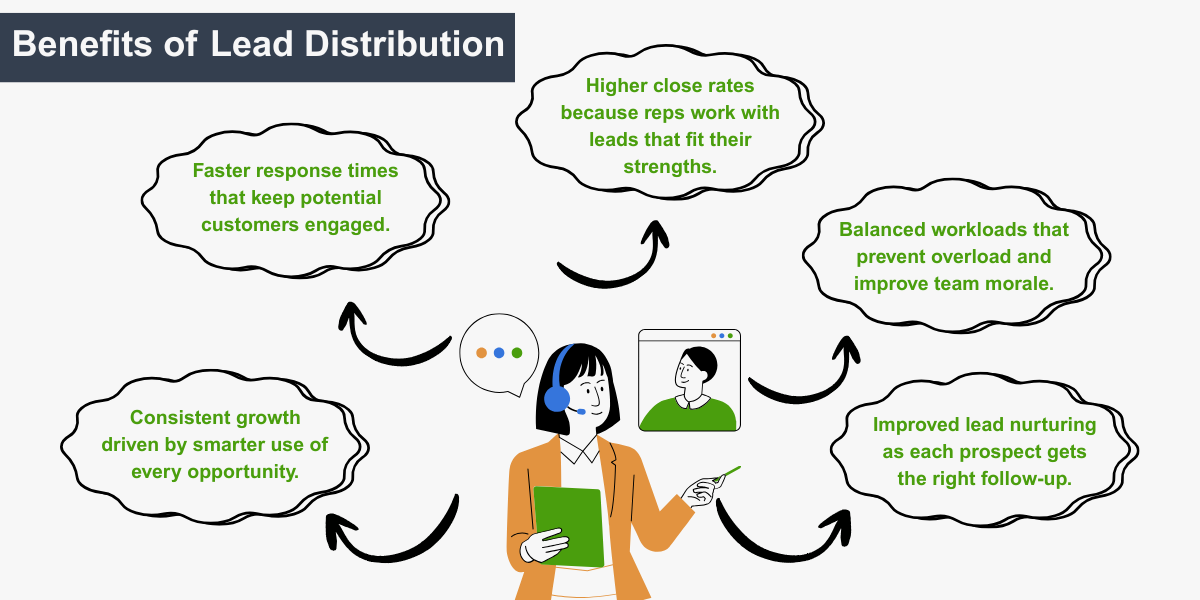
Done right, lead allocation turns random results into reliable revenue.
Smart Methods To Route Leads For Maximum Impact
Before you build your strategy, learn these methods to route incoming leads quickly and connect them with the best sales rep for increased revenue.
1. Manual Lead Distribution
With manual lead distribution, you control lead routing and can align each lead with the sales rep whose strengths fit the opportunity best.
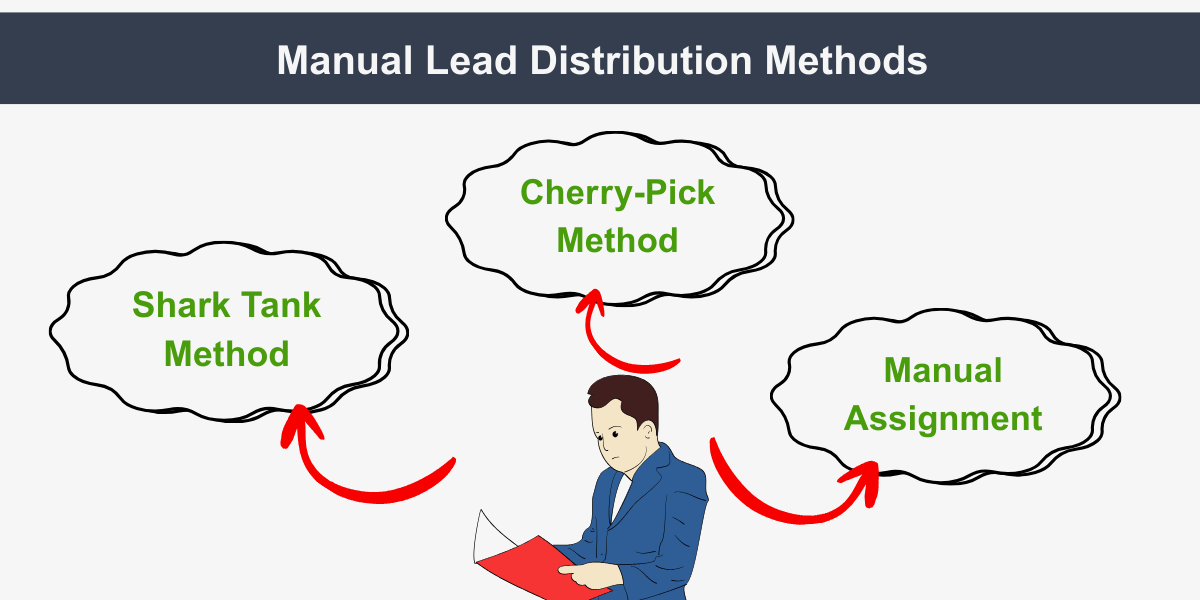
1.1. Shark Tank Method
All available reps compete to claim each new lead as it arrives, and the fastest rep to respond gets the lead. With this style, you can turn speed into an ultimate advantage to keep response times sharp and energy high.
Best For
Fast-moving sales teams that thrive on competition and aim to reply instantly, like car sales.
1.2. Cherry-Pick Method
Your sales reps dive into a shared pool of all the leads and hand-pick the ones they see as the biggest wins based on value or preference. It puts them in control and lets them lean into their strengths.
Cherry-picking works well if you target different market classes. Suppose you are in the fashion space selling items like these female mannequins. Some of your reps can choose leads from luxury fashion houses if they excel at high-value, custom orders, while others pick fast-fashion retail brands for quick, high-volume sales.
Best For
Markets with a mix of customer types and deal sizes that require different sales approaches, like real estate and B2B companies.
1.3. Manual Assignment
In this approach, a manager personally decides how to distribute leads across the sales team. The lead can be assigned based on:
- Skills
- Workload
- Lead type
It is a hands-on way to make sure every lead goes to the sales rep most likely to close it. For example, if you have a software company, assign enterprise accounts to senior reps who excel at complex negotiations, while giving smaller trial accounts to junior reps.
Best For
Sales teams that need a precise match between leads and rep expertise, especially in markets where deal complexity varies significantly, like SaaS and specialized manufacturing.
2. Automated Lead Distribution
Picture leads landing in the right inbox the second they come in. Automated lead distribution software makes it happen. This saves time and keeps your pipeline moving at full speed.
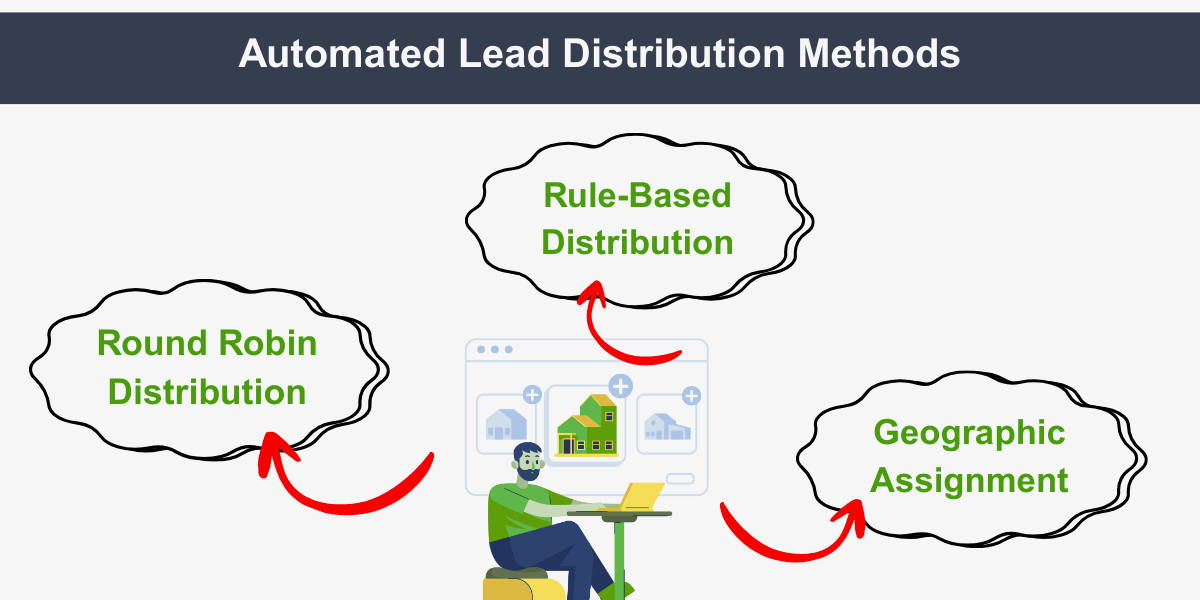
2.1. Round Robin Distribution
Think of this as a fair game where every rep gets their turn. The software assigns each new lead to the next available rep in a rotating order.
The result?
This method keeps workloads balanced no matter your lead volume. It removes favoritism, guarantees consistent opportunity for everyone, and keeps momentum high.
Best For
Environments with a constant flow of new opportunities that require fair distribution, like BPOs, where balanced workloads keep performance consistent.
2.2. Rule-Based Distribution
This lead distribution process sends every lead to the right rep based on clear rules like lead score, product interest, expertise, or deal size.
For example, you can have your system route high-scoring leads who engage with multiple demos and pricing pages straight to senior account executives, while lower scores go to a nurturing team that guides them toward readiness.
Best For
Industries with clearly defined buyer journeys where consistent lead handling is key to maintaining conversion rates at every stage, like SaaS.
2.3. Geographic Assignment
Assign leads based on geographic location so prospects connect with reps who understand their language, market, climate, and regional preferences. It makes conversations more relevant from the start.
Say you operate in the wellness space, selling products like these personal saunas. You can route leads from colder regions in Northern Europe to reps who emphasize winter wellness benefits, while sending Southern Europe leads to reps who focus on year-round health and relaxation.
Best For
Businesses where local market knowledge, regional regulations, or on-site visits play a major role in closing deals efficiently and effectively.
3. Hybrid Approach
Think of the hybrid approach as the best tag team in sales. Automation sets the pace while human judgment brings the finesse.
How does that work?
Automated lead assignment rules handle the quick wins, instantly routing everyday leads to the right rep. Then, manual lead distribution methods swoop in for the special plays, like cherry-picking a high-stakes deal.
For example, a sales team might use automation to route all East Coast leads to their dedicated geographical team, then let those reps pick the best opportunities from a shared CRM.
Best For
The hybrid approach is best for businesses that manage a high volume of leads yet still need the control to personally assign more strategic opportunities or high-value sales to the right people.
5-Step Playbook To Build A Lead Distribution Strategy That Works At Any Volume
Apply each step to refine your lead distribution system, close performance gaps, and keep it ready to handle any lead volume.
Step 1: Establish What True Success Looks Like For You
Decide what “best” means for your team. Start with these questions to shape your definition of success:
- Is it to increase conversion rates by 15%?
- Do you want to make sure every rep gets an equal share of leads?
- Is it responding to every lead your sales team receives within 5 minutes?
When everyone knows the target, every action becomes more focused.
How To Establish What Success Looks Like
Define the main goal your lead distribution strategy should achieve. To do this, look at past performance data to see which outcomes had the biggest impact on conversions and build your target around repeating or improving those results.
For example, say you are in the business communications space, like this answering service by Rosie, built for franchise owners. Here are what your goals can be:
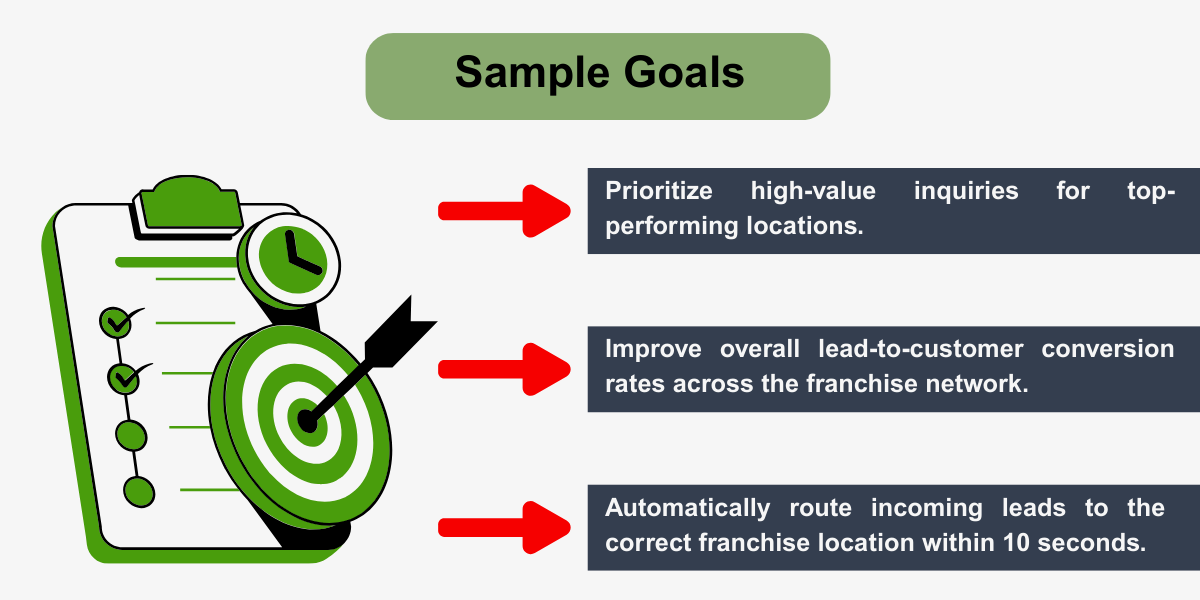
Once you have your goal, do these:
- Choose the key metrics that will measure progress toward that goal.
- Set specific targets for each metric that reflect your growth ambitions.
- Get input from sales and marketing teams to make sure the targets are realistic.
Going back to our example, here are the key metrics with target benchmarks:
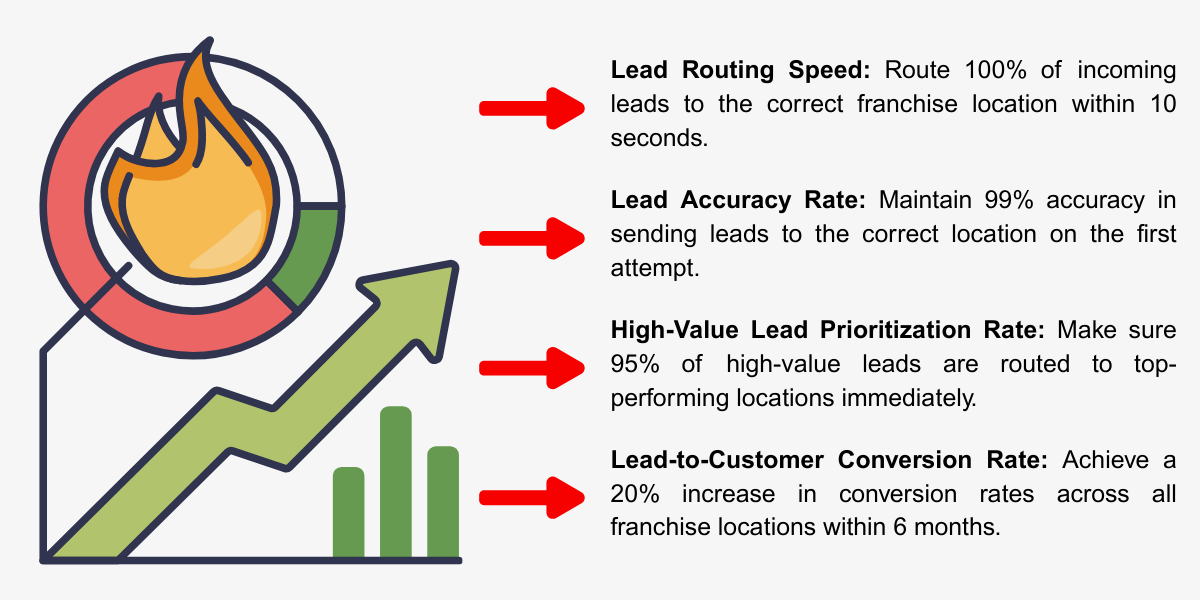
Then, document what success looks like in clear, measurable terms. Share and confirm this definition with everyone involved in lead management.
Step 2: Nail Down Your Must-Haves For Lead Qualification
Before you think about assigning incoming leads, you need to know exactly what makes them worth your team’s time. With lead qualification, your sales process stays clear of contacts who will never convert.
In addition, clear criteria can turn seemingly random prospects into qualified leads, which can make your lead response faster and more targeted.
How To Set Lead Qualification Criteria
Review your ideal customer profile. To do that, look at the profile you already have. Then, refine it using analysis of past buyers to spot patterns, like industry type, order size, and purchase frequency, that show the strongest long-term opportunities.
Once you have that, follow these:
- Set minimum budget, need, and timeline requirements.
- Score leads based on engagement and buying signals.
- Identify deal-breakers that disqualify leads immediately.
For example, suppose you are in the textile equipment space offering items like these sewing machine replacement parts. Based on your review, you find that your best long-term customers are upholstery manufacturers ordering in bulk every quarter or alteration shops needing specific parts monthly.
Based on this, your criteria can look like:

To help you with building a criterion, use this quick guide:
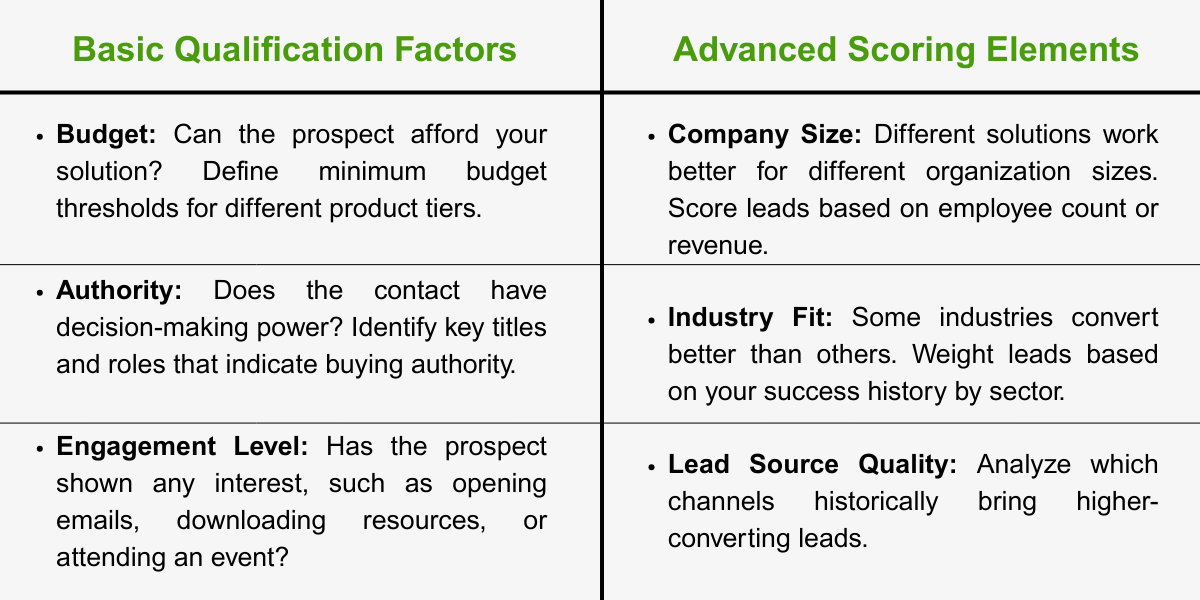
You can also use a tool like Highperformr to spot high-intent signals in real time, filter for your ideal customer profile, and score leads based on actual buying behavior.
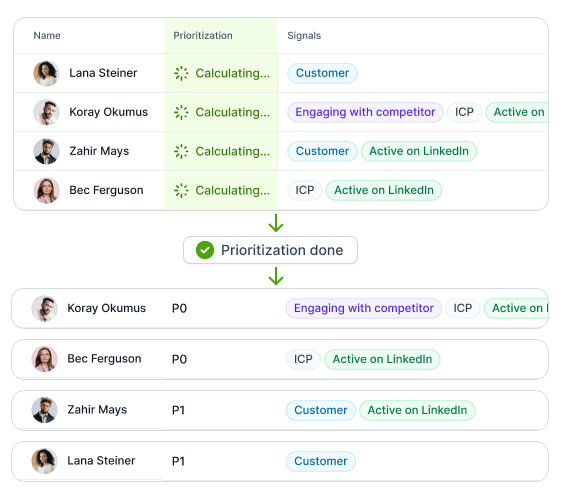
This way, you focus on real decision-makers, catch competitor moves as they happen, and prioritize the right prospects before assigning incoming leads.
Step 3: Break Down Your Team’s Selling Powers
Stop treating your sales team like they are interchangeable.
Think of them like specialized tools in a kit, each built for a different job. Some thrive in direct marketing outreach, others excel at nurturing long-term potential customers, and a few are closers who seal the deal fast.
When you match each lead to the skill set most likely to win them over, you are not just aligning leads but giving them a precision-fit experience.
How To Break Down Your Team’s Capabilities
Start with past performance data to see which members of your team are experienced sales reps consistently turning potential customers into loyal clients. Use this to get a clear picture of where proven selling power already exists.
Then, identify each person’s natural strengths. Some team members excel at turning warm interest into sales-ready leads, while others are skilled in lead generation and opening new doors.
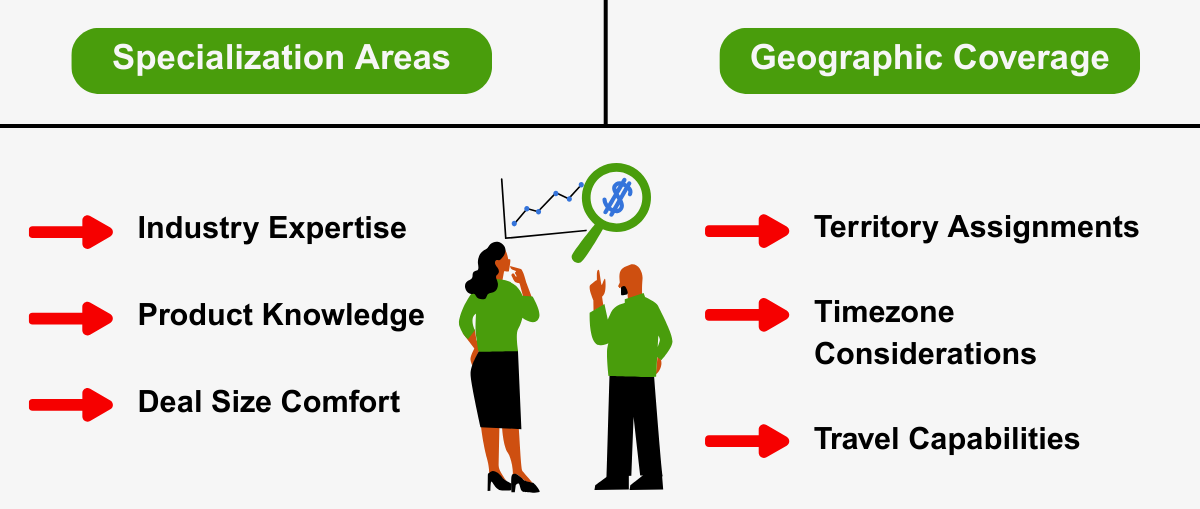
After that, look closely at your specialized sales teams. Matching their industry know-how to the right prospects can shorten the sales cycle and boost win rates.
Finally, put those skills to the test through role-plays or live sales situations. This guarantees you align leads with confidence and know every opportunity is in the hands of the person most likely to close it.
Step 4: Find the Method That Fits Your Sales Flow
What happens when your lead distribution method fights against the way your team sells?
You get delays, frustrated reps, and lost deals. A mismatched approach can:
- Leave inbound leads sitting untouched.
- Push high-value prospects to the wrong person.
- Overload specific sales reps with too many leads.
Meanwhile, the right method keeps your sales pipeline flowing, plays to each sales rep's expertise, and guarantees every lead gets the follow-up it deserves.
How To Choose The Best Method
Map your sales flow from lead capture to close. Then, identify choke points where leads slow down.
For example, you might find that your inbound leads wait days for a callback after hitting the quote request form, or your biggest opportunities keep going to reps swamped with too many leads. Flag these problems and review which methods can fix them best.
You should also decide when to assign leads based on speed or skill. To do that, track response times across your team and see who can handle initial inquiries or demo requests within minutes.
Meanwhile, give the complex or high-value opportunities to specific sales reps with deeper product expertise.
If you plan to opt for automation instead of manual methods, use the reporting tools from your advanced lead distribution software to see how each rep performs, from average response time to net conversion rate.
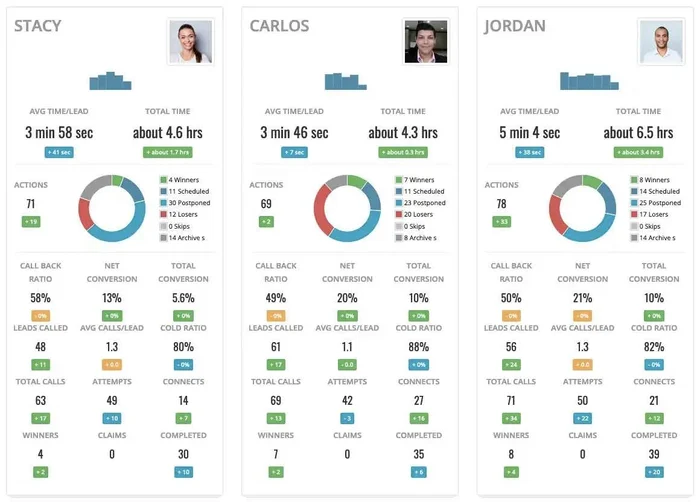
With this, you can refine your rules so each rep plays to their strengths. Plus, it can show you when it is worth investing in a more tailored system.
If you want an all-in-one solution with other features built around your process, work with a software development expert. They can create a custom platform that runs your entire sales flow in one place.
Step 5: Fine-Tune Your Process For More Leads
As lead volume increases, cracks start to show.
Hot leads might sit too long, the wrong reps might get the wrong deals, and fair systems like round robin lead distribution can break down without the right checks.
But with this step, you can monitor and fine-tune to keep your system sharp so every opportunity moves quickly from lead capture forms to closed deals.
How To Refine Your Distribution Game
To make sure your process stays effective, do these:
- Review your average response times and fix any slow follow-ups.
- Track which reps close hot leads fastest and route similar ones to them.
- Test different routing rules for complex or high-value deals to improve win rates.
- Audit lead capture forms to make sure you are collecting enough data for smart routing.
- Monitor round robin lead distribution to make sure the assignments stay fair and balanced.
- Revisit your process (e.g., monthly or quarterly) to adjust for market changes or lead volume increases.
Lastly, learn your software’s features inside and out if you plan to automate. The better you know its features and analytics, the easier it is to squeeze every bit of value from it and make smarter decisions.
3 Best Practices To Drive Better Results From Lead Distribution
Follow these best practices to keep your lead distribution strategy sharp, scalable, and ready to drive more growth.
A. Create An Internal Feedback Loop
Do not treat your distribution strategy as a “set it and forget it” system.
Design an internal feedback loop to turn every interaction with leads into insight you can act on. Instead of waiting for quarterly reports to reveal problems, you get real-time input from the people working those leads every day.
That means you can spot bottlenecks, catch mismatched assignments, and tweak rules before they cost you deals, like when a lead's industry calls for certain sales reps who know it inside out.
Here’s what you need to do:
- Compare rep feedback with CRM data to spot gaps.
- Schedule quick weekly check-ins with your sales team.
- Ask reps why certain leads were easier or harder to close.
- Document takeaways and feed them into next week’s assignments.
- Use a shared dashboard so everyone sees distribution changes in real time.
B. Keep Territory Boundaries Clear & Updated
Each one of your reps should know where their turf starts and ends. With this, the leads never get lost or spark infighting over who owns them, which slows momentum and damages morale.
Additionally, no overlap means you avoid:
- Wasting effort
- Creating frustration
- Missing opportunities
As new markets open or paying customers cluster in certain regions, you can shift boundaries without chaos.
Here’s what you need to do:
- Use CRM tagging to track territory ownership.
- Factor in travel capacity for in-person meetings.
- Communicate changes instantly to the whole team.
- Map territories visually so everyone sees the breakdown.
- Set rules for handling cross-territory referrals so there is no confusion.
Here’s an example of how you can map your territory visually:
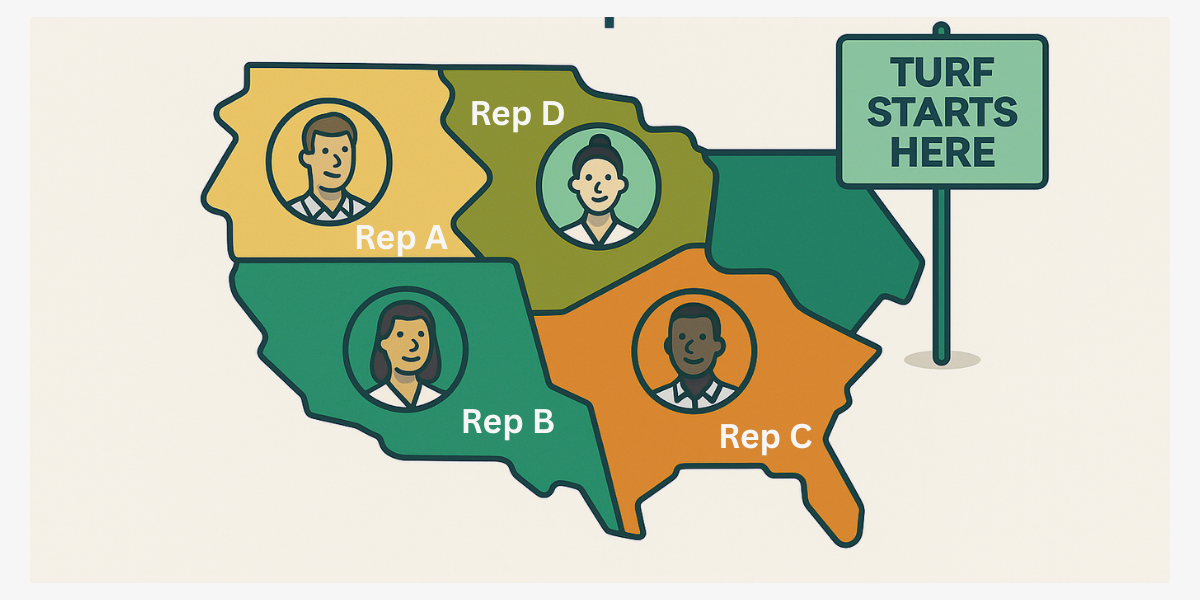
C. Maintain A Balance Between Fairness & Performance
If you only reward top performers, you can burn out your best people and leave newer reps without the chance to grow. On the flip side, if you only distribute leads evenly without considering skill or speed, you risk losing deals that need an experienced closer.
So, how do you deal with that?
The sweet spot is to find a rhythm where fairness builds team trust and performance still drives results. Use that balance to keep motivation high and spread opportunity across the team.
Here’s what you need to do:
- Use routing rules that blend fairness with skill matching.
- Audit lead flow weekly or monthly to catch imbalances early.
- Pair new reps with veterans on big opportunities for skill-building.
- Rotate smaller or simpler opportunities so every rep stays active.
- Use performance tiers to guide distribution without locking reps out of better leads.
Conclusion
You have the blueprint for a lead distribution strategy that can keep your pipeline efficient and adaptable.
The next step?
Gather your sales and marketing teams, map your current lead flow, and walk through each step in order. Spot the biggest gaps, decide which fixes to roll out first, and layer in the rest as you go.
The more intentional you are in building your system now, the more consistent and profitable your results will be in the long run.
Now, you do not have to go through this process alone. Highperformr AI can help put your strategy into action faster and with less guesswork. Use the intent signals it brings to make better decisions. Sign up now and experience how it can make your sales process faster.










